Vedat Milor's Blog, page 10
January 19, 2024
High End French Gastronomy is Alive and Well in Germany: Part 2 (Bareiss)
Luxurious Generosity
Chef Claus-Peter Lumpp is a true practitioner of Fernand Point’s belief that a great chef should capture the true taste of the food first, but also he/she should delight us with variations. Since French chef Pierre Gagnaire started his experiments to translate this suggestion into practice, “variations around an ingredient” became quite trendy. Say, one orders langoustine. One is presented with five little bites, all with different temperatures, textures, and tastes. Sometimes this idea works, and one can see the potential inherent in a given product or ingredient. But, more often than not, it does not work. The client becomes confused with the constant bombardment of small bites which are often not complimentary, but contrast with one another and tire the palate. For instance, although I will not deny Gagnaire’s talent, I usually feel like watching fireworks in his eponymous restaurant as my brain and palate may not process so many discordant elements.
But one should not throw out this idea when confronted with less than satisfactory examples. Chef Lumpp is very good with variations. I have visited Bareiss several times since 2013 and twice in 2022. He offers both a la carte and a menu degustation. His a la carte dishes are mostly composed of the type of variations I speak of here. I enjoy both such dishes as well as five to six consecutive courses on the menu degustation. When I opt for variations around, say, langoustine, veal, scallop, turbot, or foie gras I always end up satisfied. I appreciate the progression of tastes and my palate does not feel overwhelmed by discordant flavors. His menu degustation is also equally well thought out, progressing beautifully with harmonious flavors. The chef also likes to integrate a contrasting flavor or texture in some of his dishes, but since he does this in a controlled way, his dishes never feel unbalanced.
If I use two words to describe the cooking here, I would say that it is mature and generous. Combined with outstanding service overseen by the director Thomas Brandt, a beautiful and very comfortable dining room, and an excellent sommelier, Mr. Teoman Mazda, a meal at Bareiss, is not only a gastronomic experience, but it is also a testimony to a refined and civilized lifestyle which may be getting rarer and rarer. Compared to the kitsch, insincere attitudes, and self-congratulatory narratives which dominate today’s “fine dining” (well satirized in the movie “The Menu”), an escape to the Black Forest and dining at Bareiss is a breath of fresh air.

My wife, who rarely asks for foie gras in France, always orders the foie gras a la carte in Bareiss restaurant. The small dishes are different each time, but one always gets cold terrine, fresh hot liver, a crisp tart, a sweet concoction, one very rich and one less rich expression tempered by fruit. Last time we had the following:
Goose foie gras terrine of marbled goose liver with salted caramel and port;Tartlets of burnt goose liver cream and hazelnut;Goose liver praline with sesame;Fried goose liver with apple and calvados; andGoose liver ice-cream with cocoa bean crumbles.Alternatively, one can taste chef Lumpp’s excellent goose foie gras as part of the menu degustation. This is what we did last Fall. “Variations of foie gras with green apple sour cream and tarragon and almond oil” was aromatic and deeply satisfying, as the chef balanced the natural sweetness and unctuous texture of foie gras with tart apple and nutty oil.

My favorite a la carte dish is langoustine, but when he does not have it, try his multiple takes on the local char fish. One will not be disappointed. Chef Lumpp excels with seafood. He loves to cook turbot, St. Pierre, and also lobster. Sometimes he offers Spanish langostinos or carabineros.
In a recent visit we were served very good quality carabineros, followed by lobster. The carabineros were firm and juicy, and their sweet flavor was complemented well by macerated ripe mango and spicy sweet chile. The crustacean glaze and its own emulsion added umami-like depth, and quinoa imparted a crisp edge. This was good, but I liked the chef’s take on the lobster even more: a trio consisting of a light uplifting lobster tartare with the right amount of tart citrus, sweet saffron, and bitter endive; a delicious warm Breton lobster tail with earthy black carrots, spicy ginger, and an emulsion of its jus with a touch of bergamot aroma (Earl Grey); and, to top it off, a decadently rich lobster gratin Thermidor that nobody dares to prepare in today’s celebrated gastronomic kitchens. The sweetness of the cream balanced perfectly the salty-rich reduction of the carcass, and a generous quantity of medallions of Breton lobster stood their ground against such an onslaught of decadently rich flavors. All three dishes, when consumed consecutively, proved that the chef can concoct delicious and intense dishes without sacrificing the overall harmony.


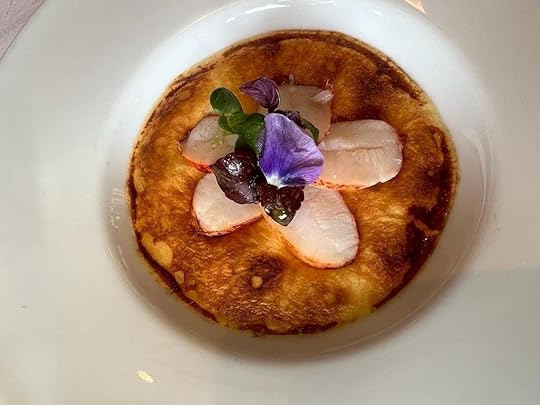
Over the years we tried several meat dishes here. Lamb and pigeon are both excellent. Their presentation follows the same logic of the rest, like the above-mentioned lobster. A tartare or a consommé, followed by a classic preparation, and a final statement exploring the rustic potential and unabashedly rich-fatty parts of the meat. For instance, if it is Alsatian pigeon, expect an excellent consommé, followed by glazed fried breast with celeriac puree and black truffles, and a ragout of the leg with a rich sauce of the goose liver. If one opts for lamb grown in “Alber Wacholderheide” in Rhineland-Palatinate, one can expect to be served not only the noble saddle of lamb, but also the more delicious belly and rustic tongue and spicy chorizo, before concluding with creamy lamb sweetbreads. These various parts of the lamb are all cooked separately and served with different emulsions. Chef Lumpp is an excellent saucier.
This said, my favorite meat here is a game dish: roe deer from the Bareiss hunting grounds. The preparation is very simple: fried saddle with Piedmont hazelnuts, wild cauliflower and jus, followed by the poached cushion (back leg) with cauliflower puree and cranberries. I have tasted many roasted roe deers in quite a few restaurants at all price levels in Europe. I may not single out one as the best, but over the years, I always find the quality here to be memorable. The roe deer here is neither too gamey, nor overly soft, and has a deep, slightly sweet and minerally taste. One can have it with an excellent German pinot noir-spatburgunder from the likes of B. Huber or F. Becker or a juicy Wasenhaus. A Rayas with a sweet exotic spicy nose, melted tannins, silky texture, and soft whistling ripe red berries on the palate may not hurt either.
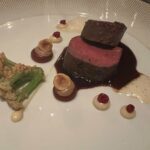
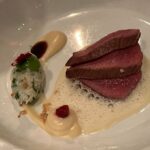
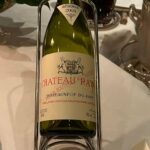
Although the breadbasket is excellent in Bareiss, I recommend consuming very little bread because the cheese quality and selection has always been very satisfactory here. Selections vary, but one can be confident to find mostly French, as well as, Italian, English, and local cheeses in optimum conditions. Cheeses, such as three years old Comte, Epoisse, Salers, Saint Marcellin, English Yorkshire blue, munster, Chablis, etc. are served with various condiments, such as thyme honey, fig jam, quince paste, caramelized hazelnut, etc.

Desserts are good and usually they are composed as three variations of a given ingredient, such as strawberry. For example, strawberry sorbet with dark chocolate, pecan cream and lemon thyme; strawberry granite with lemon and gin foam; coconut parfait with strawberry and yuzu shiso sorbet. They also have very good soufflé. But we rarely have any appetite left after we make our selection from the cheese tray. At the same time, we know that they will present an amazing array of petit fours, bonbons, chocolate covered nuts, chocolate truffles, macaroons and little tarts, in a chariot consisting of several levels. We don’t know any other restaurant which is so generous with sweets to accompany coffee, with the exception of Da Vittorio in Bergamo, Italy.


EVALUATION: 19/20
High End Gastronomy is Alive and Well in Germany: Part 2 (Bareiss)
Luxurious Generosity
Chef Claus-Peter Lumpp is a true practitioner of Fernand Point’s belief that a great chef should capture the true taste of the food first, but also he/she should delight us with variations. Since French chef Pierre Gagnaire started his experiments to translate this suggestion into practice, “variations around an ingredient” became quite trendy. Say, one orders langoustine. One is presented with five little bites, all with different temperatures, textures, and tastes. Sometimes this idea works, and one can see the potential inherent in a given product or ingredient. But, more often than not, it does not work. The client becomes confused with the constant bombardment of small bites which are often not complimentary, but contrast with one another and tire the palate. For instance, although I will not deny Gagnaire’s talent, I usually feel like watching fireworks in his eponymous restaurant as my brain and palate may not process so many discordant elements.
But one should not throw out this idea when confronted with less than satisfactory examples. Chef Lumpp is very good with variations. I have visited Bareiss several times since 2013 and twice in 2022. He offers both a la carte and a menu degustation. His a la carte dishes are mostly composed of the type of variations I speak of here. I enjoy both such dishes as well as five to six consecutive courses on the menu degustation. When I opt for variations around, say, langoustine, veal, scallop, turbot, or foie gras I always end up satisfied. I appreciate the progression of tastes and my palate does not feel overwhelmed by discordant flavors. His menu degustation is also equally well thought out, progressing beautifully with harmonious flavors. The chef also likes to integrate a contrasting flavor or texture in some of his dishes, but since he does this in a controlled way, his dishes never feel unbalanced.
If I use two words to describe the cooking here, I would say that it is mature and generous. Combined with outstanding service overseen by the director Thomas Brandt, a beautiful and very comfortable dining room, and an excellent sommelier, Mr. Teoman Mazda, a meal at Bareiss, is not only a gastronomic experience, but it is also a testimony to a refined and civilized lifestyle which may be getting rarer and rarer. Compared to the kitsch, insincere attitudes, and self-congratulatory narratives which dominate today’s “fine dining” (well satirized in the movie “The Menu”), an escape to the Black Forest and dining at Bareiss is a breath of fresh air.

My wife, who rarely asks for foie gras in France, always orders the foie gras a la carte in Bareiss restaurant. The small dishes are different each time, but one always gets cold terrine, fresh hot liver, a crisp tart, a sweet concoction, one very rich and one less rich expression tempered by fruit. Last time we had the following:
Goose foie gras terrine of marbled goose liver with salted caramel and port;Tartlets of burnt goose liver cream and hazelnut;Goose liver praline with sesame;Fried goose liver with apple and calvados; andGoose liver ice-cream with cocoa bean crumbles.Alternatively, one can taste chef Lumpp’s excellent goose foie gras as part of the menu degustation. This is what we did last Fall. “Variations of foie gras with green apple sour cream and tarragon and almond oil” was aromatic and deeply satisfying, as the chef balanced the natural sweetness and unctuous texture of foie gras with tart apple and nutty oil.

My favorite a la carte dish is langoustine, but when he does not have it, try his multiple takes on the local char fish. One will not be disappointed. Chef Lumpp excels with seafood. He loves to cook turbot, St. Pierre, and also lobster. Sometimes he offers Spanish langostinos or carabineros.
In a recent visit we were served very good quality carabineros, followed by lobster. The carabineros were firm and juicy, and their sweet flavor was complemented well by macerated ripe mango and spicy sweet chile. The crustacean glaze and its own emulsion added umami-like depth, and quinoa imparted a crisp edge. This was good, but I liked the chef’s take on the lobster even more: a trio consisting of a light uplifting lobster tartare with the right amount of tart citrus, sweet saffron, and bitter endive; a delicious warm Breton lobster tail with earthy black carrots, spicy ginger, and an emulsion of its jus with a touch of bergamot aroma (Earl Grey); and, to top it off, a decadently rich lobster gratin Thermidor that nobody dares to prepare in today’s celebrated gastronomic kitchens. The sweetness of the cream balanced perfectly the salty-rich reduction of the carcass, and a generous quantity of medallions of Breton lobster stood their ground against such an onslaught of decadently rich flavors. All three dishes, when consumed consecutively, proved that the chef can concoct delicious and intense dishes without sacrificing the overall harmony.



Over the years we tried several meat dishes here. Lamb and pigeon are both excellent. Their presentation follows the same logic of the rest, like the above-mentioned lobster. A tartare or a consommé, followed by a classic preparation, and a final statement exploring the rustic potential and unabashedly rich-fatty parts of the meat. For instance, if it is Alsatian pigeon, expect an excellent consommé, followed by glazed fried breast with celeriac puree and black truffles, and a ragout of the leg with a rich sauce of the goose liver. If one opts for lamb grown in “Alber Wacholderheide” in Rhineland-Palatinate, one can expect to be served not only the noble saddle of lamb, but also the more delicious belly and rustic tongue and spicy chorizo, before concluding with creamy lamb sweetbreads. These various parts of the lamb are all cooked separately and served with different emulsions. Chef Lumpp is an excellent saucier.
This said, my favorite meat here is a game dish: roe deer from the Bareiss hunting grounds. The preparation is very simple: fried saddle with Piedmont hazelnuts, wild cauliflower and jus, followed by the poached cushion (back leg) with cauliflower puree and cranberries. I have tasted many roasted roe deers in quite a few restaurants at all price levels in Europe. I may not single out one as the best, but over the years, I always find the quality here to be memorable. The roe deer here is neither too gamey, nor overly soft, and has a deep, slightly sweet and minerally taste. One can have it with an excellent German pinot noir-spatburgunder from the likes of B. Huber or F. Becker or a juicy Wasenhaus. A Rayas with a sweet exotic spicy nose, melted tannins, silky texture, and soft whistling ripe red berries on the palate may not hurt either.



Although the breadbasket is excellent in Bareiss, I recommend consuming very little bread because the cheese quality and selection has always been very satisfactory here. Selections vary, but one can be confident to find mostly French, as well as, Italian, English, and local cheeses in optimum conditions. Cheeses, such as three years old Comte, Epoisse, Salers, Saint Marcellin, English Yorkshire blue, munster, Chablis, etc. are served with various condiments, such as thyme honey, fig jam, quince paste, caramelized hazelnut, etc.

Desserts are good and usually they are composed as three variations of a given ingredient, such as strawberry. For example, strawberry sorbet with dark chocolate, pecan cream and lemon thyme; strawberry granite with lemon and gin foam; coconut parfait with strawberry and yuzu shiso sorbet. They also have very good soufflé. But we rarely have any appetite left after we make our selection from the cheese tray. At the same time, we know that they will present an amazing array of petit fours, bonbons, chocolate covered nuts, chocolate truffles, macaroons and little tarts, in a chariot consisting of several levels. We don’t know any other restaurant which is so generous with sweets to accompany coffee, with the exception of Da Vittorio in Bergamo, Italy.


EVALUATION: 19/20
January 6, 2024
Nomicos: A Disappointing Meal with Many Problems
I will not dwell on the fact that a wine advertised on their site (2001 Gauby) was not available at the restaurant. But I don’t want to hide my disappointment when learning that “Menu Truffe”, which I had reserved was not available. Let me add that when reserving the “Menu Truffe”, I had requested them to call me in case they did not have it. In addition, I had called the restaurant a week earlier to request them to call or message me in the event they did not have the requested menu. They did not!
All of this is regrettable, but perhaps one can still leave the restaurant satiated and happy if the cuisine is good. Unfortunately, this was not the case. We ordered the chef’s special appetizer, truffle and foie gras macaroni with parmesan. Mr. Nomicos is the first person who came up with this creation which is now served at Le Bristol and at La Grande Cascade where he worked. I only had chef Frechon’s version at Le Bristol which made an impression. Nomicos’ version was not bad, but did not reach that level. Perhaps it was too subtle as it lacked the flavors it promised. I would not have known that it contained truffles had it not been described that way.
But the real disappointment was the main course that both my wife and I ordered. “Caille en deux cuissons laquées d’un jus au vinaigre de cerisier, tiande légumes du sud” sounded great. Unfortunately, it did not deliver. The quail was dry, almost inedible. The sauce was uninspiring, and the thigh was OK. The vegetables were fine, but not special. I should say that we have had four different quail dishes in four different California restaurants in the month preceding our meal at Nomicos: Chez Panisse in Berkeley, Cotogna, Delfina in San Francisco, and Auberge du Soleil in Napa. All of them were very good, infinitely superior to the Michelin star Nomicos in Paris.
At least we had a fine cheese course and an excellent dessert. “Granité à L’Absinthe, Marmelade de Tomate à la Vanille, Glace Fenouil” was not only original, but also delicious. The acidity and the sweetness of tomato complemented very well the sharp anise flavor of the absinthe granita and the savory fennel ice cream. The dessert was light, but intense. They also offered a delicious brioche with orange cream to dip it in at the end of the meal with coffee.
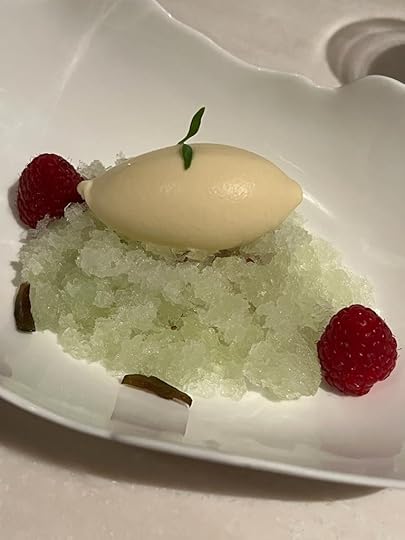
Mr. Nomicos seems to have found the right alchemy to keep his Michelin star and attract English speaking clientele. First, he has found a staff who are genuinely nice, and, above all, speak English. Second, he has put his menu (with eye catching descriptions) and wine list online in English to get attention, even if neither the wine nor the menu is actually available. Third, he concocts dishes which at least appear very competent in the photos and conform to certain techniques and parameters highly prized by Michelin to get and keep a star. Fourth and as crucial as the other three, he has to make sure that desserts are very good and generous. In the end, it is the last bite that matters to most customers, and especially the American clientele is fond of (and partial to) desserts.
EVALUATION: 10/20
December 10, 2023
Quality in Every Bite: Table by Bruno Verjus
Table de grande qualité! Verjus = Quality.
I have been visiting this restaurant since it opened, and the cooking and service keeps improving; but the obsession to source only the best ingredients remains a constant. Yes, the seating at the bar is uncomfortable, and 400 Euros for the menu degustation is steep. It is justified since Verjus never settles for less than top-notch ingredients. If there were a gold medal for the best purveyor of the finest ingredients, I would cast my vote for him!
His emphasis is on fish and shellfish, but I am always amazed here by the quality of vegetables, meat, and cheese too. It is not the quantity, but the quality. For instance, he only offers three to four cheeses, but they are amazing. While writing this review, I salivate mentioning the raw milk sheep blue, regalis, and the raw milk “Le Briard” from the Sainte-Colombe farm.
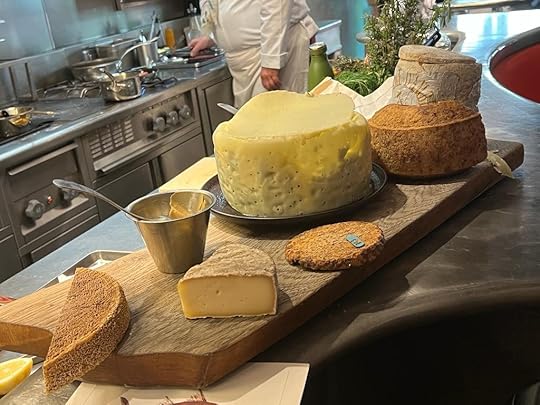
He recently started working with Roderick Sloan to source amazing shellfish from Norway. Nevertheless, his sources vary. He brings his sardines from Saint-Gilles Croix de Vie in Loire. His excellent pigeon comes from Joel Poirier in Brittany. He buys bread from the Persephone bakery which is close to his restaurant. I have not asked the origin of each ingredient, but I am sure I cannot find them for home consumption. I would have loved to find the same asparagus, peas, and turnips.
Of course, the question is how to combine and cook great products. After several visits I am confident to say that he and his young assistants cook like good Spanish chefs. That is, they don’t overcook. They respect the texture and quality of the products. They know what should be served raw, fresh, or aged properly. For instance, the scallops and razor clams are alive right before they are served, but the turbot or tuna has been properly aged. He cooks his lobster simply by pouring hot clarified butter on it, and it works. His lobster is juicy and sweet.
As a high-end French restaurant, the next question is how they handle ingredients and enhance their taste at Table. Great chefs master the art of preparing fresh sauces, combining the right sauce with the correct ingredient to highlight its flavor. Moreover, it is crucial to combine different elements in a dish in such a way as to achieve perfect harmony. Some great creations possess almost a transcendental quality in the sense that they look simple, but bear the signature of the chef and may not be easily imitated. In my lifetime, I have encountered such dishes only a few times at Chapel, Girardet, Robuchon, Outhier, Senderens, Pacaud, and Passard in France, and Ibai and a few others in Spain.
I will not claim that Verjus reaches similar greatness yet. On the other hand, he achieves remarkable consistency and almost all of his offerings are very good. In my last two visits we only had one dish, the pork belly dish with espardenyes and puntarelle, which was undercooked. The texture was chewy. I don’t think that the two main ingredients, the pork and espardenyes, achieved perfect harmony. This said, pork can work with espardnyes. I remember a dish from the early days of Can Roca when Joan Roca combined espardenyes with pork feet. The textures matched and the two were complimentary. To use a cliché, the sum was more than its constituent parts. I would like to open a parenthesis here. “The land and sea” combinations are part of the traditional Catalan cuisine. In Catalonia, such combinations are based on tradition. Elsewhere and nowadays, it became a sign of “creativity”. Two or three macaroon aspiring chefs are frequently experimenting with such combinations, but they are mostly unconvincing. This reminds me of the fate that has befallen the “tattoos”. Once having a tattoo was a sign of “individuality”. Now tattoos became standard, where one chooses from the blueprints already in store. A similar argument can be made of a colored streak in your hair which is different than the main color. Once it was an expression of a unique style, but now it is commonplace.
I am afraid Verjus is falling in the same trap. In my last visit, after he received the second star from Michelin, he started toying with “creative” combinations. Dishes, such as Langoustines with pig ear and razor clam with veal brain, were not problematic dishes, like the pork-espardenyes combination, but they were not as convincing as his other courses. Before Covid, I have eaten sweetbread and brain dishes separately from the chef, and both were outstanding.
Fortunately, these are the exceptions. We thought very highly of the rest of the meal during the last two visits. The only other meat dish, the pigeon with a rich mole sauce that contained anchovies and beetroot, was outstanding. Honestly, I can’t think of a better pigeon dish in France, and I may order it as full course in my next visit.
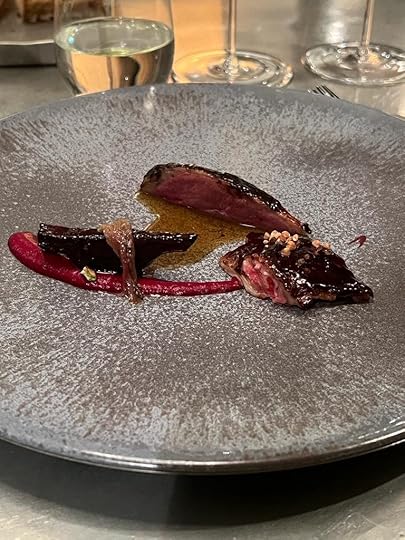
There are too many very good vegetables, fish, and shellfish dishes to talk about all of them, so let me arbitrarily select three.
The thick piece of turbot, cut from the bone and full of gelatin, with a shellfish reduction, optimally acidified by verjus, and thickened with saline turbot eggs, was a triumph. Harmonious, balanced, and delicious, this may be a reference point for French style turbot.
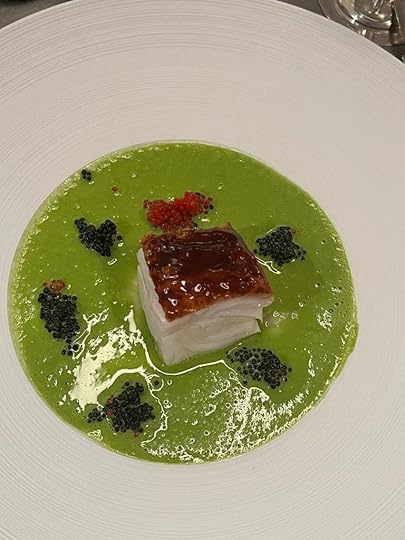
Let’s consider a trio: an amazing quality wild oyster from Norway with dill; live diver scallops from Norway with salted butter and a scent of sweet-smelling blur; razor clams with Mallemont asparagus from Grasse, pistachio crumbles and lemon balm oil. Since all three shellfish dishes were of pristine quality, they did not need more than minimum handling and seasoning. Verjus’ comparative advantage lies in capturing the essence of the sweet-saline flavor of shellfish and enhancing it with a light herbal oil infusion and a well thought out garnish. Bravo!
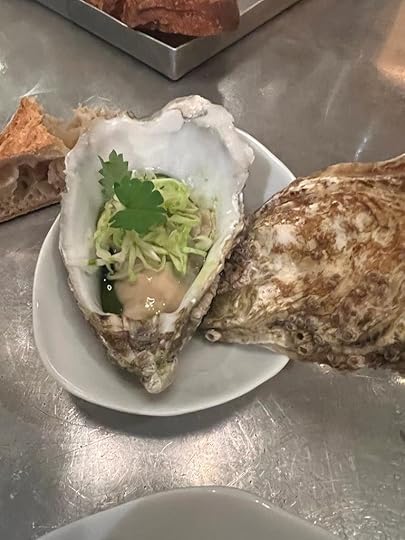
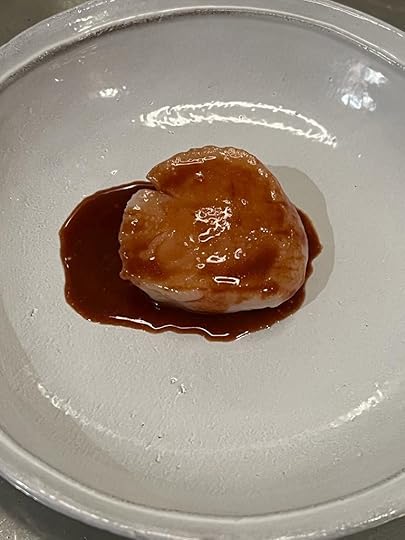
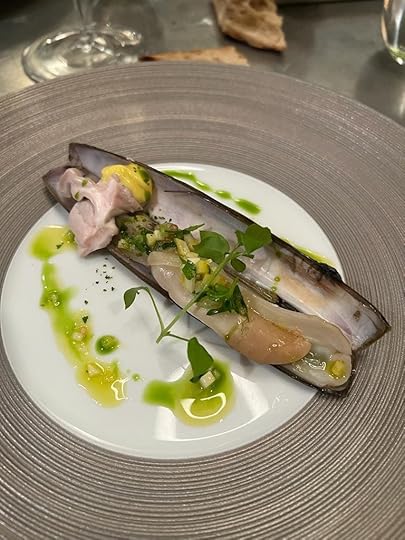
As I alluded above, his lobster is also terrific. The Brittany blue lobster, tail and claw, is cooked simply by the infusion of very hot clarified butter flavored by the jus of the lobster head and shell. The texture is subtle, the meat is very juicy, and the surface is caramelized. The lobster is served with an herbal infusion whose components may change. Besides fennel and parsley, Verjus loves tart, bitter, saline, and crunchy herbs. He typically makes a “remoulade”, or mayonnaise, flavored by sea plants, capers, and nettles. In spring he also includes firm grilled artichoke among the garnishes. His lobster has remarkable depth of flavor.
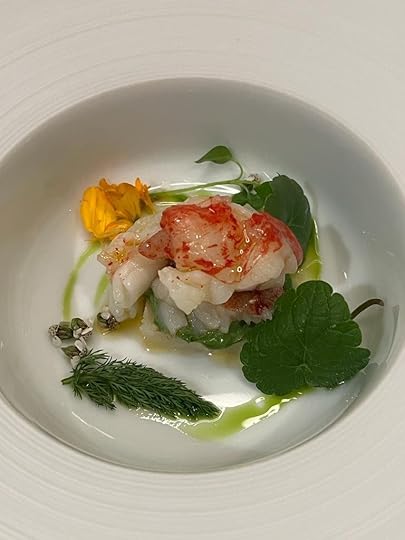
Desserts have improved here. There is a remarkable chocolate tart with caviar. The sablet au chocolat with ganache is made from excellent Venezuelan chocolate, supplied by Francois Pralus in Roanne. The briny caviar actually works with chocolate, not dissimilar to salted caramel. This is a decadent dessert and apt to end an impressive meal.
EVALUATION: 18/20
December 1, 2023
Assiette Champenoise and Its Gastronomic Highs and Pies
In 2022, we have been twice in this Michelin three-star restaurant near Reims, in the Champagne region. I have also celebrated my birthday there, pairing 2015 La Tâche with fallow deer fillet and pigeon pie with foie gras. My biggest disappointment was the pie. Apparently, it is a dish created by the father of the current chef, Mr. Arnaud Lallement. This dish reminded me of the strongest period in high end French cuisine before the about turn to a lighter cuisine inspired by modern trends in Spain, Scandinavia, and Japan. On my first trip to this restaurant, my wife and I had a half portion of a pie each and loved it. So, the second time we ordered one whole each, but we were still served half of the pie each. This is because most three-star restaurants today operate like sophisticated conveyor belts, which minimize error at the expense of tailoring to the clients’ particular needs. For the sake of consistency and cost minimization, gastronomic restaurants churn out degustation menus. The pigeon pie turned out to be in the degustation menu and no matter what you want you will get a half portion as the sous chef in the assembly line is expected to maximize efficiency. This is the same fate that has befallen the amazing signature baked pasta dish at Le Cinq restaurant. The portion is half size compared to what used to be served at the chef LeSquer’s old restaurant, Ledoyen, as this dish is now offered in the degustation menu.
The pie is stuffed with precisely cooked pigeon breast and foie gras. The spinach between the crust and pigeon fillet ensures that the meat is kept moist. The crust is buttery, flaky, and not soggy. The red wine-based sauce, which is enriched by pigeon offals, is very rich and a good foil for the foie gras that keeps its texture inside the pie. The baked turnip and the confit tomato served with the pie are stuffed with the pigeon thigh cooked to perfection. This is a great dish.
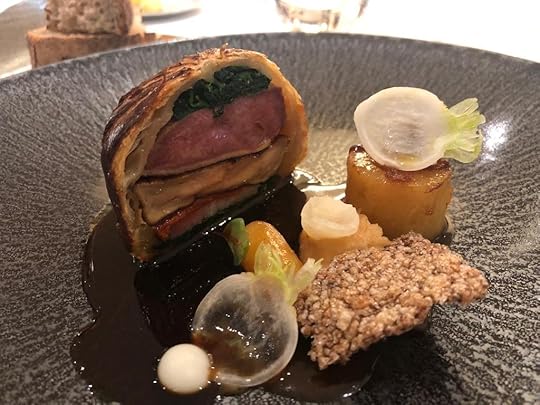
There is another great dish of a very different sort. It is actually served as an amuse. It comes after the nice little tarts and fritters that accompany our glasses of champagne at the very beginning of the meal. The second amuse is actually more than a tidbit; it is like a full portion first course. It is called “ruche de notre parc” in French or “beehive in our park”. The chef created this dish, which is composed of beeswax, pollen, propolis, and agrumes, like orange and grapefruit. Apparently, they have bees in their garden-park, and they make their own honey. The honey comes in different textures, like creamy, foamy, dehydrated, crisp, waxy. I cannot tell which component of the honey got transformed to each texture, but I can say that it is a multi-layered and rich but not a cloying dish. The agrumes’ aroma and flavor that they integrated into the honey balance the sweetness by imparting bitter acidity and freshness. Chef Fatih Tutak, the only two-star Michelin testaurant in Istanbul’s Turk restaurant, also serves honey as an amuse, but the sweetness and cloying sensation compromises our taste buds in the beginning of the meal. Here “the beehive” titillates our taste buds. I will call this the best amuse I have had last year.
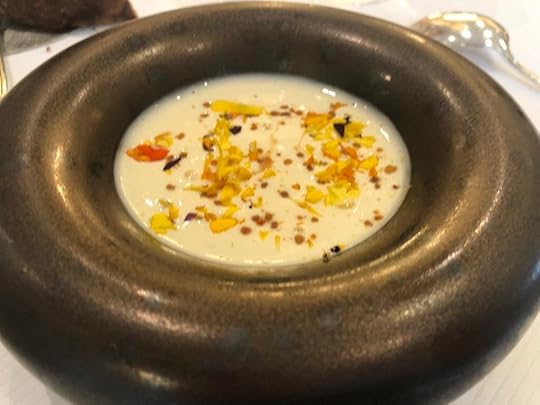
The rest of the dishes we have tried in the two visits were all good to very good, but not as memorable. The kitchen cooks the game dishes very precisely. We tried “biche” or fallow dear twice with Alba truffles. It was served with a light jus, onion rings, and rhubarb. I thought the jus and the garnishes were a little too simple. The Alba truffles were wasted in the dish as the game meat is too strong to showcase the complex taste of the pico magnatum. I would have preferred more earthy and also sweet components, such as chestnuts, celery root puree, apple puree, cranberries, etc. Sometimes tradition bound classic preparations are the best.
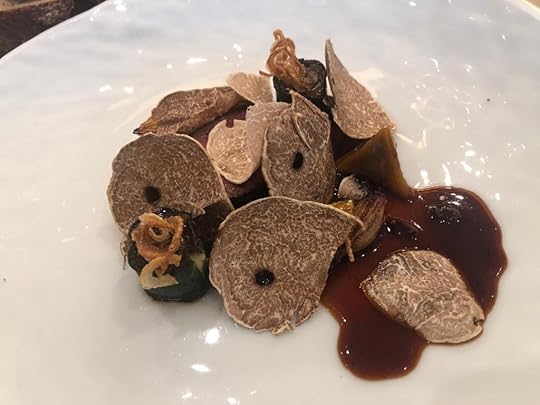
We also tried gnocchi with Alba truffles. The combination worked, but they have to work on the gnocchi technique to render them more light and feathery, like one finds in good Italian restaurants.
Both the scallops and the turbot fillet, which was cut from the bone of a 12 kg. turbot, were cooked à la plancha. The sauces and garnishes were very good. Allemand is an excellent saucier and his “vin jaune” sauce with the turbot, which was enriched by cooking the bones to get the gelatin, and his light buttery infusion with lardo, that was served in a separate bowl with the scallops, were both excellent. The young green cabbage filled with tripe served with the scallops, and the young leeks with the turbot, were also top notch ingredients. Yet, both of these dishes fell short of greatness because they were a tad over-cooked. Unfortunately, this is a problem with the majority of French restaurants. They cook seafood beyond the optimum point.
I liked the blue lobster though. The lobster dish is dedicated to the chef’s father, and the lobster is perfectly cooked with an intense but not overly reduced sauce which contains lobster head, wine, and herbs, such as thyme and sage.
We also thought highly of their cheese selection from Philippe Olivier, as well as the local crusty bread. The desserts we tried in our first visit were adequate, but neither the variation on Piedmont hazelnuts, nor the chocolate dessert made a strong impression. The gourmandizes, like little fruit tarts, nougat, chocolate truffles, lollipop, etc., that came with our coffee, were quite satisfactory though.
EVALUATION: 17.5/20
November 26, 2023
Between Brilliance and Bland: Deconstructing Guy Savoy’s Three-Star Experience
I have first been at Guy Savoy in 1986 when they had two Michelin stars. It was less fancy than many high-end restaurants, but one of the best. The dishes looked simple, but actually they were well thought out and delicious. I visited the Rue Troyes address a few more times, and they have always delivered a very good meal.
In the new and very sophisticated Hotel Monnaie location we also dined quite well, and drank even better. The 2012 Roulot Meursault Meix Chavaux was superb, and the 2015 Cote Rotie Jamet was too young but already impressive. The cooking was good, but somehow it was less consistent than in past visits. That is, if half of the dishes were superb, the other half were quite good, but not what one expects from a three-star restaurant. At any rate, I wonder why Michelin removed the third star given that one can eat here at least as good as many current Michelin three macaroon restaurants.
There is a menu, but we decided to go for a la carte: Tuna, Salmon, Rouget-barbet fish, Artichoke soup with truffles, and Suckling lamb from Lozere.
Amuses were seasonal and pretty good, featuring fresh baby peas, radishes, cucumber, and more. I especially appreciated the baby peas from the Basque region in Spain as they were presented in different textures and in their own jus. Sweet and succulent, they exploded on the palate.
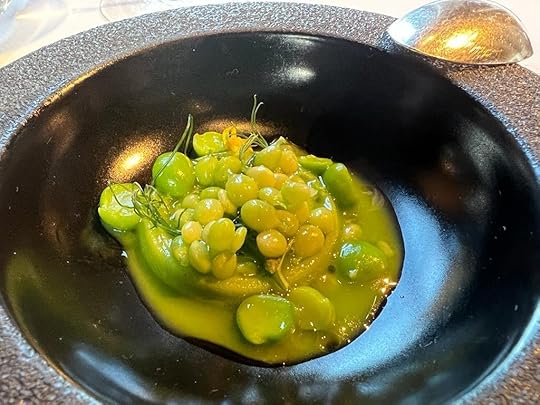
The one other dish which was perfect is Savoy’s legendary cold artichoke soup with chicken stock, parmesan, and black truffles. It is served with a delicious brioche spread with truffle butter. The soup is intense, earthy, rich, but not heavy as some drops of lemon balance the umami dimension. When drinking a spoon of soup and then biting into the brioche, the combined taste effect is heavenly and the aftertaste is long. Having the soup with Roulot’s Meursault was a perfect match.
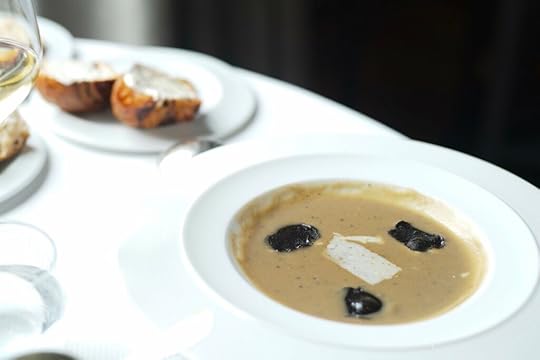
The tuna, the salmon, and the lamb were all good, but not “wow” dishes. Tuna is served two ways: raw with aromatic herbs, and in a taco with Oscietra caviar from China. They also bring a clear infusion in a long glass and recommend that half of this olive oil-tomato juice infusion is poured on raw tuna while one drinks the other half. Overall, the dish is good, but not on par with toro-otoro nigari sushi in a good Japanese restaurant or what a German chef, like Bau at Victor’s Gourmet, can accomplish with tuna. The salmon is prepared at the table and is served with lemon caviar on top. They pour a vegetable-seafood broth on it that is enlivened by lemon juice. The infusion works with the oily salmon, but the salmon itself is not as subtle in taste as, say, Adour salmon. Overall, this is a fine dish that I expect in a good French bistro.
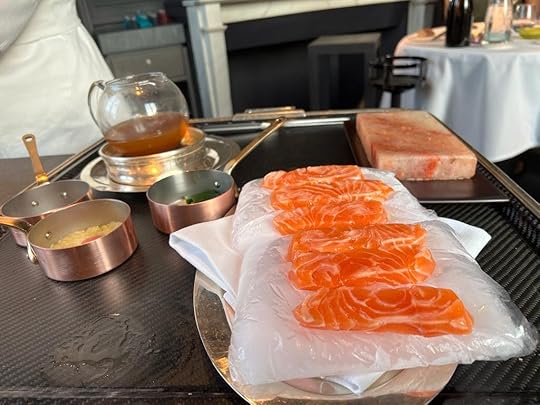
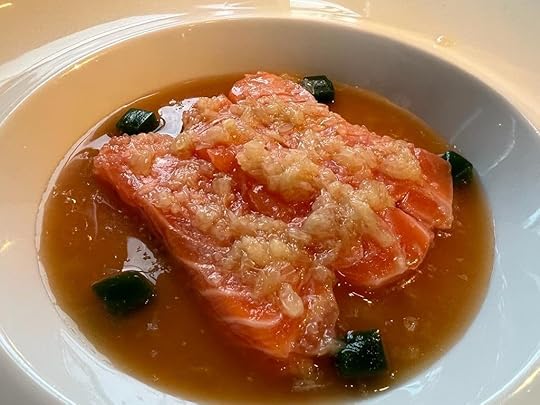
But I have never seen in a good bistro present a dish at the level of the next dish: mussels and mousseron mushrooms in a seafood veloute with sorrel leaf. A pedestrian ingredient, creamy mussels, were combined with the rare, earthy, nutty and firm mousseron mushrooms in a rich yet delicate broth; a memorable “terre et mer”, sea and mountain dish. Actually, we had not ordered this dish, and it came as a courtesy of the restaurant. I am glad it came because this is the type of dish I would like to see at Savoy.
The rouget-barbet was also very good, as they served it with a shellfish reduction with saffron and rouget liver. There was also a nice zucchini flower stuffed with shellfish. The fish was fresh and perfectly cooked, and the sauce was complex, and its pleasant bitterness enhanced the sweet flavor of the rock fish. My extra wish would have been to serve rouget liver on the side, as I am used to having it at Elkano and find the liver of fresh rouget to be an incredible experience.
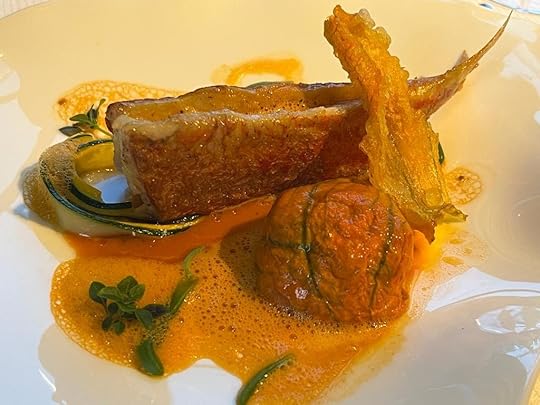
We liked the young Lozere lamb, but we did not think it was on par with the soup, the mussel, and the rouget courses. We had two nice lamb chops, their own jus, a roasted tomato stuffed with shredded leg of lamb, a piece of lamb sausage and herbs. I found the quality of the lamb to be good but not great. On the other hand, we liked the “vol au vent” stuffed with internal organs and morels more than the main part of the dish.
The millefeuilles with Tahiti vanilla was top notch.
EVALUATION: 17/20
November 17, 2023
Plénitude: Navigating Arnaud Donckele’s Culinary Journeys
I dined at La Vague d’Or, Chef Arnaud Donckele’s restaurant in Saint Tropez, and was awed by the luxury, setting, and presentations. However, I was unsure whether it was merely a sophisticated and good restaurant or a truly great one. I had reserved my judgment, but was interested in trying it again. The second time occurred in Paris at Plénitude, inside the Cheval Blanc hotel, where Arnaud Donckele was personally cooking. I concluded that he is indeed a highly skilled chef, and the restaurant is deserving of its three Michelin stars. However, I am still uncertain about his distinctive style and contribution to cuisine. He left me with the impression that he is still searching for his place among the great cuisiniers of France. While he may not have reached that pinnacle yet, given his young age, goodwill, and evident talent, he has the potential to achieve a higher level in the future. I also appreciate the fact that he is making an effort to bring “sauces” back to French cuisine in an era when many young chefs mimic trendy Scandinavian trends.
His dishes are all good to very good. The restaurant makes a great effort to make sure that clients understand the nature and composition of each dish, including the amuses. To this end, detailed written descriptions are provided. Romantic titles are accorded to each tidbit that is served before the appetizers. For instance, a single snail is served in a bowl containing wild herbs and flowers. They also bring snail bouillon in a glass and call it “rosee de printemps”, the spring dew. The broth contains snail essence flavored by dried duck breast jus, onion, fennel, Roma tomatoes, celery, ginger infusion, lemongrass, star anise, chardonnay and pastis reduction, yuzu juice, fresh fennel essence, olive oil, lemon peel, and Maniguette pepper.
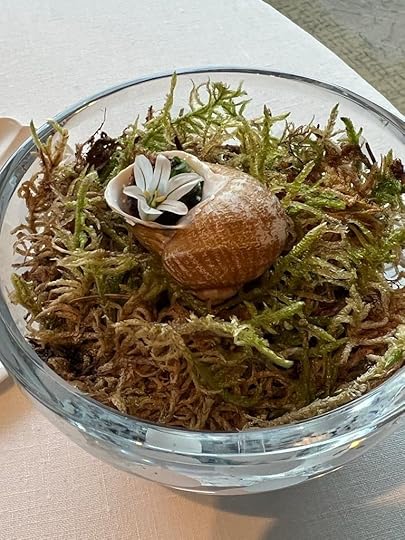
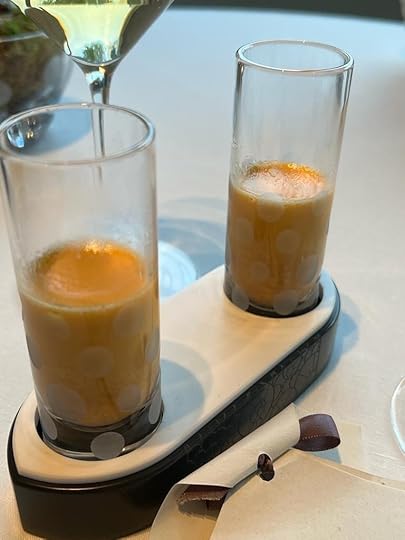
If the complexity of the bouillon is mind boggling, the composition of sauces or infusions that accompany various appetizers and main courses are more so. After we composed our menu, they gave us a handout of sauces for each separate course. Donckele’s take on sauces, or more accurately his French style dashi, worked well with the seafood dishes. For example, the “Vinaigrette Ambroise” went well with crab and white asparagus as the salinity of the seafood stock, acidity of lime, bitterness of grapefruit and sweetness of pine honey made a balanced sauce with depth and highlighted the sweet crab and earthy white asparagus. The chef likes fresh, bright, aromatic citrus with seafood, but he balances the acidity with other elements. “Cornaline” vinaigrette, composed of several citrus fruits, herbs, bergamot oil, white balsamic, cucumber juice, etc; and thickened by langoustine broth and its corral, was served with the langoustine. “Velours D’Eden”, a sauce that reminded me of Spanish salpicon (the best lobster salpicon was at Ibai in Donostia), was served with grilled and de-boned sardines. In the handout they provided, the ingredients of “Velours D’Eden” dashi are listed as “grilled sardines, escabeche fumet, Lambrusco vinegar, bonito vinegar, lemon juice, tarragon infused olive oil, egg yoke, Callas mustard, fennel brunoise, Maniguette pepper.” I bet a great ramen master in Japan may get an idea or two from Donckele’s broths.
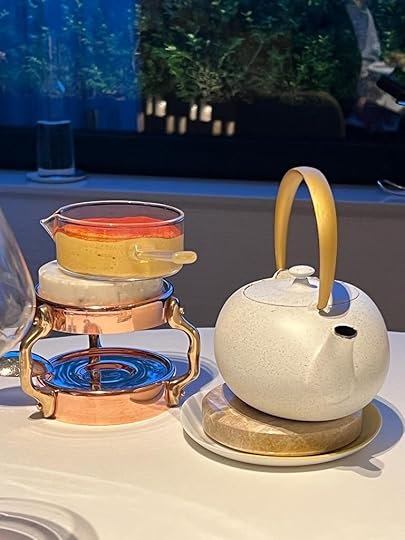
We continued with two of my favorite seafoods: rouget fish and Spanish red shrimp from Palamos. For the former the dashi he pours on the dish is called “Bravade”. The use of pastis and cognac together with rock fish fumet, sea urchin essence, and citrus fruits reminded me of a very tasty and original bouillabaisse broth, and honestly I would have loved to dip their excellent crusty bread to mop up the “Bravade” sauce. Bravo!
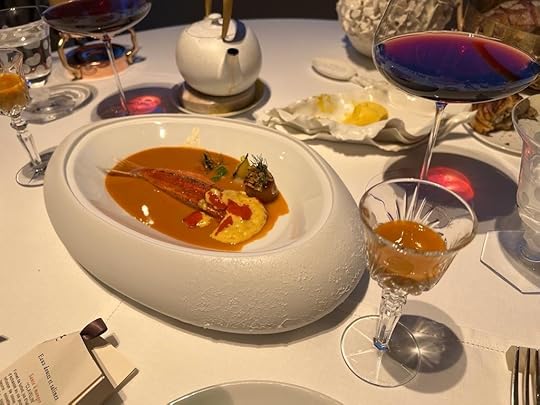
The other dashi served with the red shrimp, “Sabayon Procope”, was equally tasty and also Mediterranean inspired. Donckele also used a Pinot Noir reduction here, possibly thinking a pairing it with red wine.
I had the following thoughts after tasting these dishes. The rich and complex sauces were all very good and balanced. The chef did a very good job differentiating them, i.e. they all had different aromatic profiles and taste, well-tailored to the seafood they accompanied. We liked all of them, but especially the rouget dish, photographed above, and gave it a perfect score.
The langoustine and red shrimp were also very good. The langoustine was served with artichoke and Buddha hand citrus fruit. The red shrimp was served with bergamote and asparagus. The combinations were good, but the quantity of the shellfish was the problem. They serve half portions, but then there is too much sauce for the tiny bit of seafood. To illustrate this point, I am including a langoustine photo. One needs at least double, if not triple the amount of langoustine tails to truly appreciate this dish. Small portions work for some restaurants, such as La Table du Verjus, reviewed below, but they work less well with Donckele’s style. If Donckele is bringing back complex sauces of Escoffier cuisine, he should also be more generous with his portions to complete the picture.
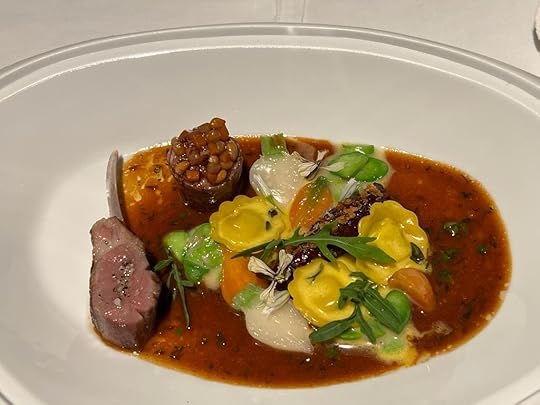
Still, I enjoyed the seafood dishes, but was less convinced with the meat. We tried both lamb and pigeon. The lamb was served with spring vegetables and edible flowers, and the pigeon was with a little tart stuffed with giblets and herbs. The “Jus Delicatesse” sauce with the pigeon and the “Ecole Buissionniere” jus with the lamb somehow tasted quite similar and lacked complexity despite the 10+ ingredients used in each. For instance, the sauce for pigeon counts smoked anchovy and olives among its constituents, but I could not taste the umami dimension in the sauce which lacked depth. I also found the lamb and the pigeon to be good quality, but a bit simple. The level was on par with what you find in high-end bistros in Paris. Somehow, they need more work to bring meat dishes on par with the seafood offerings.
The restaurant seems to have an excellent cheese course, but we were too full to try it. We liked the rhubarb dessert with Beaume de Venise sweet wine and excellent vanilla extract.
EVALUATION: 17.5/20
November 12, 2023
Maison Lameloise: Tradition Lightened by Eric Pras, but Where’s the Culinary Spark?
After a 30-year hiatus, my wife and I re-visited Lameloise. Memory plays tricks, but what I remember is that the cooking was steeped in tradition and the sauces were excellent. We had enjoyed an amazing wine from an average vintage year: 1984 H. Jayer.
Obviously the chef is different. It is no longer the Lameloise family. Now Eric Pras is at the helm. His cooking is well adapted to the times: lighter. There is an emphasis on pretty presentations: a bit chi-chi, and precious. It cannot be called regional cuisine, but there is a nod to tradition with some amuses, such as tartlettes with jambon persille and beignets of frog legs with persillade.
The menu contains plenty of nice and high-quality ingredients: scallops, langoustines, lamb from the Pyrenees, pigeon, fresh peas, morels. They serve nicely composed dishes; the types of dishes that will please everybody and will offend nobody.
But something is missing. This is a good place, but not an exciting restaurant. It is hard to pinpoint what is missing. Technically, Pras is immaculate. Perhaps he plays it too safe. Perhaps it lacks a bit of depth. It is also possible that a bit of a rustic dimension is needed to make the dishes more memorable.
Pras is not someone who likes bold statements and flavors that characterize typical bourgeois cooking, such as internal organs (les abats) and deeply flavored cuts of meats and fish. Instead, he likes subtlety that sometimes can be bland or too self-consciously pretty without depth. For instance, the “omble chevalier” appetizer, cold trout and cold smoked eel decorated with a sun shaped potato chip, with sorrel glazed potato spheres, white asparagus, roasted buckwheat grains and fish bouillon is pretty to look at, but is rather fussy, over-complicated, and lacks some depth.

The chef makes ample use of bouillons in other seafood dishes, such as scallops and “lieu jaune” fish. The problem is that the “bouillons” are meant to be the equivalent of Japanese “dashi”, but they fall short. The meat dishes, the spring lamb and the pigeon, thankfully are served without bouillons and with proper French sauces. They are good, but lack the extra “wow” factor when compared with the excellent lamb dishes I had in Germany at Victor’s Gourmet and Waldhotel Sonnora the following week (reviewed here).
EVALUATION: 16/20
November 5, 2023
Tales from Le Cinq: Navigating the Flavors of Excellence and a Few Potholes
Christian Le Squer is an excellent chef, and his food has been already reviewed here when he was at the helm at Ledoyen. Now at Le Cinq, he trained his kitchen brigade well, and they are able to reproduce his classics day in and out. Assisted by a very professional and courteous service team under the direction of Mr. Baumont who is a well-known wine expert, there is no doubt that the restaurant deserves its Michelin three stars rating. Some of the Le Squer classics, such as large Breton langoustines served in their shell with a warm sabayon and tomato tapenade; sea bass with buttermilk; gratinee Cevennes onions with a rich meat jus-parmesan-bone marrow sauce; oven baked spaghetti with truffle, ham, and Parisian mushrooms in a creamy morel mushrooms sauce; and his sweetbreads in an acidified herbal sauce, are all very accomplished dishes. Overall, the chef is a great saucier and his dishes taste complete and well thought out. In addition, even his more complex dishes are not devoid of focus.
My favorite dish here is the signature pasta dish mentioned above. Calling this just a pasta dish is like saying Messi is a fine football player, an understatement. Just as Messi has redefined the possibilities for a forward player, Chef Le Squer’s rendition of “Spaghetti Debout en Gratin” pushes culinary boundaries in its own right. It is actually a timbale in a rectangular shape. The rectangle is formed by vertical strands of spaghetti mixed with a good dollop of butter and parmesan. It is stuffed with very tasty ham and mushrooms infused with rich cream. On top of the rectangle case stands another layer of pasta garnished with crispy ham sticks and truffles. The dish is presented with a mushroom infused cream sauce. It is an incredibly rich and soul satisfying dish which is, miraculously, not heavy. I don’t know the secret, but what I know is that, when the dish is cut open, it does not fall apart and holds its shape. This can be seen from the second photo. So, the pleasure of devouring this dish lasts to the very end.


There is also one signature dessert that I adore: “Croquant de Pamplemousse Confit et Cru”. There are successive layers of confit grapefruit, raw grapefruit infused with vanilla and lime, and also sorbet of grapefruit, in this amazing dessert. The texture and the balance between sweet, tart and herbal (basil) are extraordinary.
I have one qualm though. Le Squer seems to be rarely present in the kitchen, unlike when he was at Ledoyen. At Ledoyen he used to prepare some seasonal surprise dishes. Another problem is that since the spaghetti timbale is in the tasting menu, even if one orders it à la carte, one is served a small portion size. This is a half portion and not a full portion. I guess the house does not want guests to order this dish à la carte, and the portion size has suffered as a consequence.
Too bad! Hence I am giving Le Squer a half point less than last time.
EVALUATION: 18/20
June 26, 2023
High End Gastronomy is Alive and Well in Germany: Part 1 (Waldhotel Sonnora)
A Symphony of Balance and Depth
Chef Helmut Thieltges was neither a globe-trotting culinary superstar, nor a creative “genius” pretending to revolutionize the art of eating. Instead, in the vein of some of the best chefs of the last century, such as Fernand Point, Alain Chapel, Freddy Girardet, Joel Robuchon (Jamin period), Harald Wohlfahrt, etc., he stayed in his kitchen, searched for not only the best of available seasonal products, but also luxurious ingredients, and tirelessly prepared complex sauces from scratch and without shortcuts, worthy of Escoffier. Instead of pursuing trends and turning high-end gastronomy into a quasi-theatric medium to express the celebrity chef’s boundless ego, he always put a premium on preparing flawless and delicious dishes to satisfy all his clients. I dined there several times and thought that he was one of the last practitioners of Point’s famous maxim that “cooking is for capturing the taste of the food (main ingredient) and then enhancing it, as a composer may take a theme and then delight us with his variations”.
His early death in 2017 was a tragedy, reminiscent of the great Alain Chapel’s unexpected departure. Was it the end of an era? I thought so until I tasted his second in cuisine Clemens Rambichler’s dishes. Honestly, had I not known about the tragic event, I would not have been able to tell that there was a change at the helm of the kitchen here. It is obvious that like all great cooks, Thieltges transmitted all his knowledge and experience to his assistant Clemens who is now constructing harmonious and delicious dishes.
In 2022 I dined there a total of four times, twice in May and twice in October. Was this too often? I think it was not enough given that we could not try everything, and there are dishes I would not mind having every day! The young chef, who is not the biological child of his predecessor, is respecting his legacy more than many young chefs who succeed Michelin starred fathers. There is another maxim attributed to Point that “perfection is lots of little things done well”. This was the operating principle of Thieltges’ cuisine. The same principle now underlies Rambichler’s approach and practice.
The display of perfectionism begins with the amuses here. When I went there on two consecutive days, they brought different amuses, but with no difference in terms of quality. They are all delicious, bursting with flavor. For instance, we were offered razor clams with an orange vinaigrette and cauliflower cream; Passard (Arpege) level delicate little tarts with beetroots, horseradish cream, and veal tartar; and a trio of a Gilllardeau oyster with dill and caviar, salmon label rouge with wasabi ice cream, crab with sea beans and a coulis of tart apple. In all three sets of amuses, grassy, crunchy, and refreshing herbs combined well with sweet-briny seafood, or earthy-meaty elements, such as beetroot, while a touch acidity felt in each bite (from the citrus) sharpened our taste buds. One notices that optimum calibration of different elements and textures served to enhance the flavor of the shellfish, as opposed to masking or obfuscating its flavor.
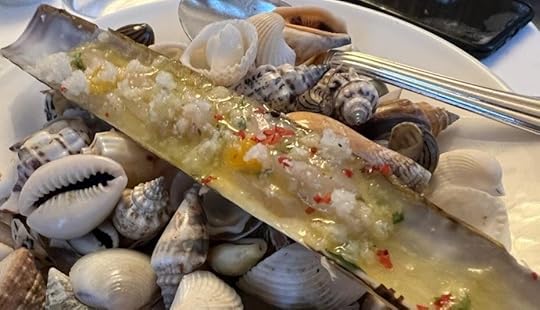 Razor clam
Razor clam
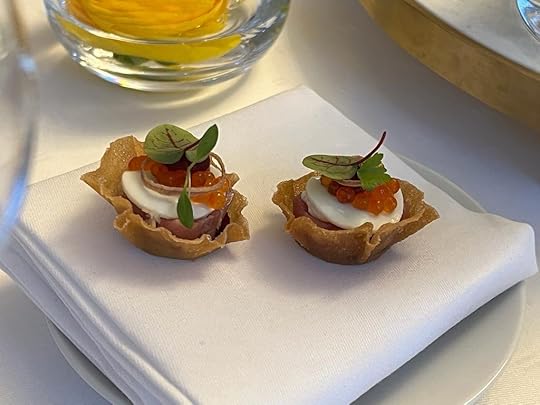 Tarts
Tarts
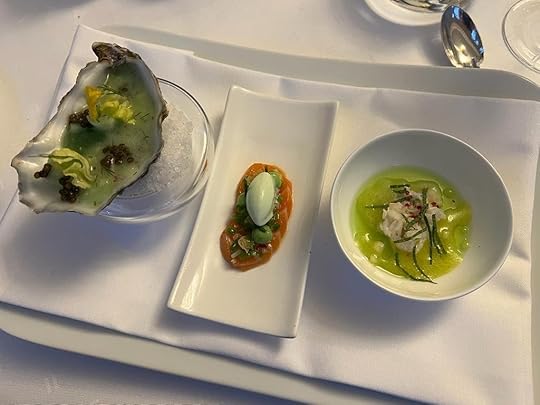 Trio
TrioFollowing the amuses, the diner can either choose a la carte or order the menu Sonnora which is actually a relatively good value at 220 Euro and changes not only seasonally, but even daily. Many signature dishes are usually on the menu, such as the “beef tartare with caviar served on potato rosti”. One can also order this dish a la carte, which is preferable since it contains 20 grams of caviar, instead of 15 grams as part of menu Sonnora.
There are plenty of a la carte choices. The carte is composed of four sections: Starters; Fish and Seafood; Meat and Poultry; Desserts. There are typically four dishes in each section. The menu Sonnora, on the other hand, is composed of five savory dishes (with a selection between two for meat), the cheese course and two desserts. We typically go for a la carte one day and opt for the menu the second day.
We have tried almost all of the starters, and they are consistently good. We always get the beef tartare with caviar, the 20 gram version. This is a fabulous dish which has balance, depth, and focus. The tartare of veal is the level of fassona beef tartare from Piemonte, and the caviar is plentiful and supplied by N25. This rich combination works on its own, but what elevates this dish to a superlative level is the combination with rosti. It is very light and crunchy, and the three elements together, combined with crème fraiche, create a unique alchemy.
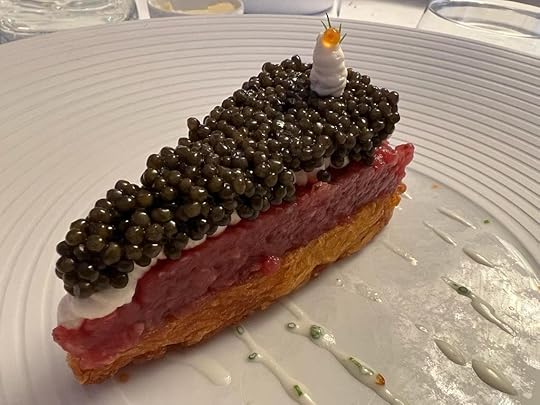 Beef tartare with caviar
Beef tartare with caviarFoie gras marinated in ice wine with walnuts, and oysters with caviar, are also excellent, but another starter that merits a perfect score is the scallop dish. (In May it was on the menu, but not in October.) It is presented in two services, not together as many restaurants do, but one at a time. First, thinly sliced raw Dieppe scallops, marinated “en rayure” with kohlrabi, tarragon oil, and lime. Second, “chaud-froid” and foie gras “Cru” with 50 years old balsamic vinegar, pine nuts. and a chive, olive oil vinaigrette. The first part is presented in a large scallop shell. The sliced raw scallops sit on a crustacean jelly, and some dollops of N25 caviar adds further brine to the sweetness of the scallops, balanced by citrus acidity and the earthiness of the gelee. The second serving is more assertive yet equally harmonious. The combination of excellent quality scallops with tiny slivers of foie gras and the chive vinaigrette enriched by sweet syrupy balsamico creates small gustatory explosions on the palate.
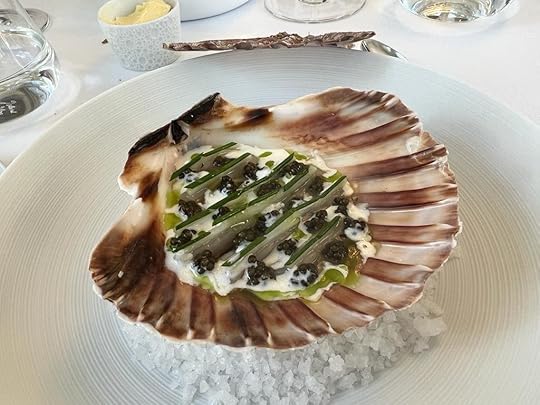 Scallop
Scallop
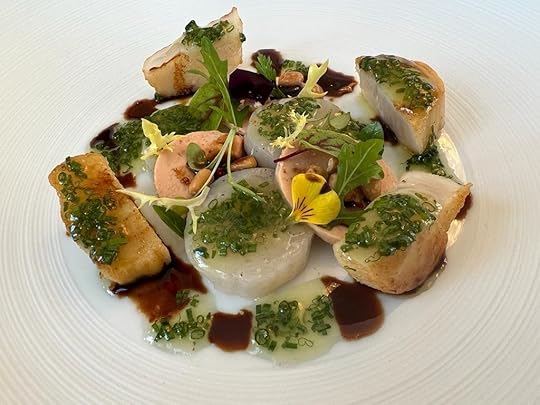 Scallop
ScallopIf one decides to go a la carte, one will face a conundrum: lobster, turbot, or sole…. They are all very good, and chef Ramblichler is an accomplished saucier. For instance, take the turbot. Waldhotel always procures a very large Atlantic turbot weighing seven to eight kilograms in excellent condition, since it is killed by the ikejime method to preserve its flavor. When you order it a la carte, the chef cuts a thick slice from the bone, hence does not lose the best part, i.e., the flavor of the gelatin and the dense viscosity of the fish. (Contrast this with the cottony soft texture of turbot in the high-end Scandinavian restaurants that I reviewed here.) In spring he offered turbot from la Rochelle with slices of marinated scallops and parsley in “nage” from old Riesling 1992. In Fall, it was the turn of grilled Turbot from La Rochelle with bouchot mussels from “St Brieuc” in a sauce containing anise, fennel, and Iranian saffron. Both were prime examples of Point’s maxim that cooking should first capture and then enhance the taste of food.
Turbot, sole, and lobster are all excellent choices, but I have a soft spot for the langoustine, probably because I adore the taste of langoustine which is subtler and sweeter than lobster. I also rarely encounter prime quality large langoustine from Brittany or Galicia. I would be more than pleased with langoustine grilled whole in the shell, but I can’t think of a more captivating sauce than Sonnora’s version. Grilled langoustines “Royale” with spicy mango “Par Avion” and lime-butter sauce “Beurre Bordier”. He serves a jumbo langoustine tail of top quality. The langoustine is first grilled and then pan fried in brown butter, and served in a sauce of shellfish reduction, ginger, mango, and lime. The Chef adds very thinly sliced ripe mango and fresh crunchy green cabbage to the dish. The sauce also includes interesting crunchy seeds, which turned out to be buckwheat seeds. We tasted citrus acidity, spice, sweet mango, buckwheat seeds, and shellfish! There seems to be too many and excessive flavors. I can see how many chefs will ruin the langoustine in a similar preparation. But when tasted, one notices that Rambichler created a complex, multi-dimensional yet very balanced concoction from a luxurious ingredient. This dish is on par with Bernard Pacaud’s celebrated langoustine dish at L’Ambroisie.
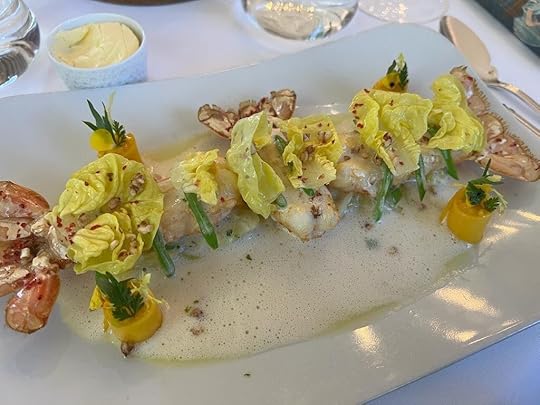 Langoustine
LangoustineBefore the meat course, my wife and I usually share a sweetbread preparation. We both love this “lollipop for grownups” and think that one gets a near perfect preparation here. “Saute of sweetbreads and small champignon mushrooms, with parsley jus, vin jaune and black truffle from Perigord” was near perfect. This is a classical preparation and all the elements blended very well. The sauce was exquisite. Actually, there were two sauces: a parsley jus, surrounded by vin jaune beurre blanc. The sweetbreads were perfectly cooked, crunchy outside and creamy inside. Preserved truffles were as good as they can be, and duxelles mushrooms and crispy lettuce blended well with the dish. This was another triumph.
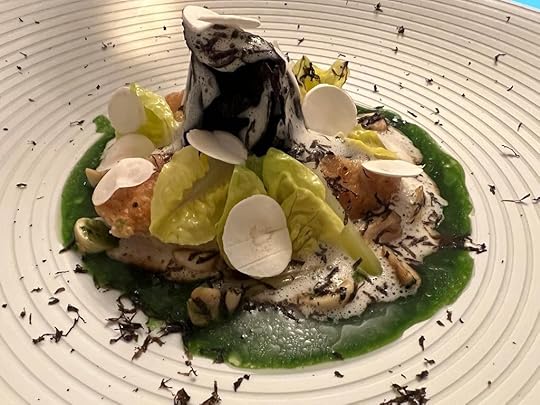 Sweetbreads
SweetbreadsMany chefs know how to add more and more ingredients to a dish and, as many claim, it is harder and more important to know when to stop. It is perhaps equally crucial to be a master of control when you combine several ingredients and a rich sauce. The expertise of Thieltgeis was exactly that, and Rambichler is also following the same path. We have tasted four meat preparations from him, and all of them are testimony to his ability to seek new horizons without sacrificing the integrity of the main ingredient. His “etouffee pigeon” in spring and saddle of venison with buckwheat crepe, pistachio gremolata and a very rich Rouenaise red wine sauce with bone marrow and foie gras merit perfect scores. The Rouenaise sauce itself is a chef-d’oeuvre. His Kagoshima A5 Wagyu presented in two services is very good too, but has not yet been perfected, in my opinion.
But what I want to highlight here is the Spring lamb. It is partially because I rarely find very high quality lamb cooked to perfection. It is also because I appreciate using some of the tastiest parts of the lamb that are often discarded in high end cooking. I value very much the co-existence of rustic simplicity with elaborate subtlety. Alain Chapel was the undisputed master of this hard to achieve harmony, and the lamb dish here is a product of a similar philosophy: “Carre and saddle of Limousin lamb with calf head jus, lamb tongue and dried tomatoes with hollandaise of garden herbs”.
Allow me to use a cliché saying that the young lamb dish was like “the bounty of spring on a plate” with an extra. The natural sauce of the lamb had extra depth from slivers of lamb tongue and the gelatin of calf head jus. This rustic dimension of the jus was balanced with the light and flavorful Hollandaise of garden herbs. The lamb was very tender yet flavorful, which made me think that it was beyond the suckling stage as you could taste wild thyme in each bite of the rack of lamb. The light Hollandaise, which rather tasted like a sabayon, was in tune with the lamb’s quality. Fresh spring vegetables consisted of artichoke, aubergine caviar, red peppers, peas, and fava beans. A judicious use of red pepper mousse in the sauce added extra complexity to this beautiful lamb dish from the Pyrenees.
 Lamb
LambThe quality of the desserts here does not lag behind the savory courses. In Spring we enjoyed aromatic French gariguette strawberries with rhubarb, rhubarb gelee, mascarpone ice cream, fromage blanc, and basil oil with pine nuts. In Fall we appreciated the equally good figs perfumed with aged port, sour cream sorbet, acacia honey vinaigrette, and hazelnut oil.
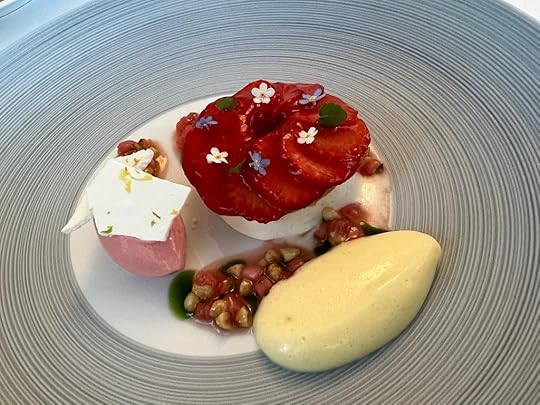 Gariguette strawberries
Gariguette strawberries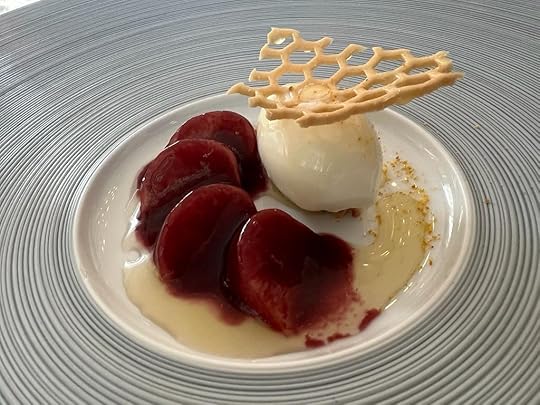 Figs
FigsAdd to all of these a remarkable cheese trolley with good selections, excellent breads, high end sweet tarts, chocolates with coffee, and a wine list with depth and fair prices. The service is efficient, but friendly, and the time between the courses is optimum. One does not feel rushed, but one does not wait too long between the courses either.
Waldhotel Sonnora sits perfectly in the fairy tale like Mosel with amazing wines, beautiful scenery and kind people.
EVALUATION: 19.5/20
Vedat Milor's Blog
- Vedat Milor's profile
- 23 followers



